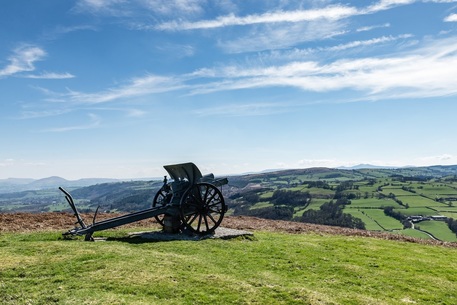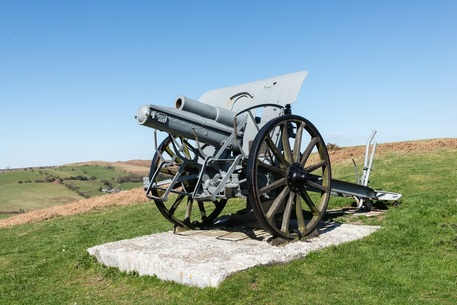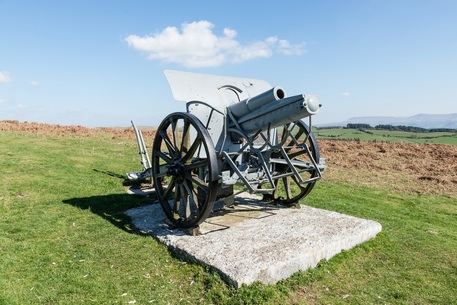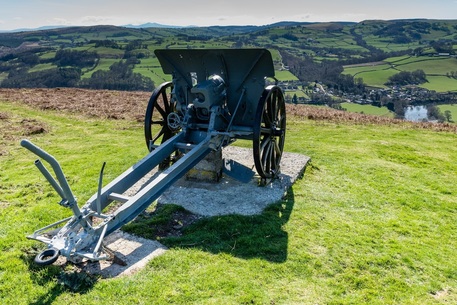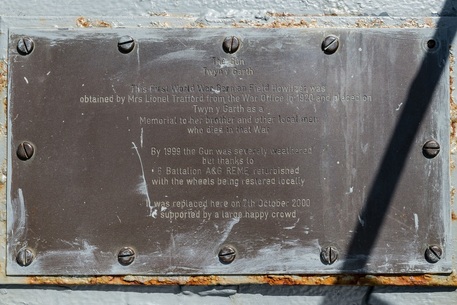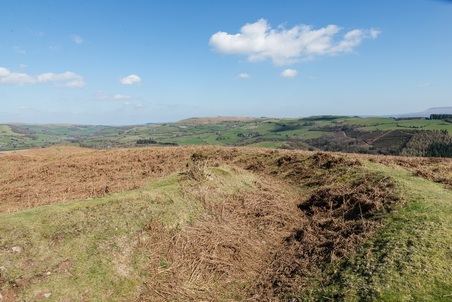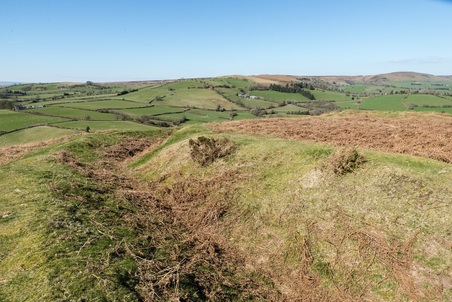The German Field Gun on Twyn y Garth
|
Unless you happen to know that there is an old German field howitzer on top of the hill known as Twyn y Garth in Llandeilo Graban, you would probably not notice it at all, even if driving past just a few hundred yards away. However, once you have made the effort to make the reasonably short if rather steep walk up to the gun and enjoyed the really fine views across the river Wye above Erwood and over to the Black Mountains and Central Brecon Beacons you will always spot it whenever you are in the area. But what on earth is it doing there?
After the First World War, Nessa Williams-Vaughan (later Mrs Lionel Trafford), daughter of Mr and Mrs John Williams Vaughan of the Skreen, Llandeilo Graban, arranged to purchase the gun from the War Office after it was advertised for sale. Nessa acquired the gun to commemorate the end of the First World War and in memory of her elder brother John, an officer in the South Wales Borderers, who was killed in action in the Somme in July 1916, and also to honour other local men who were killed in the Great War. Unfortunately, Mrs Trafford died soon afterwards when she was involved in what was reputed to be the first fatal motor car accident in Herefordshire. The gun was delivered by rail in 1920 to Erwood Station and, after some rivalry between the men of Erwood and those of Llandeilo Graban, it was dragged by men and horses and positioned adjacent to the Old British Camp on Twyn y Garth, where it was cemented in place. It was apparently suggested that the gun was deliberately aimed at the Wheelwrights Arms in Erwood. After nearly 80 years in this highly exposed position its condition had deteriorated very considerably; the wheels had collapsed, the chassis was severely corroded and the tail was almost disconnected from the body. This deplorable state was posing a possible threat to the public and therefore Painscastle Community Council decided that an attempt should first be made to get the gun renovated as a Millennium Project before considering its removal to prevent its becoming a real hazard. The Council was very fortunate to be put in contact with the 6th Battalion Royal Electrical and Mecahnical Engineers, who kindly undertook to renovate the artillery piece to a condition which would withstand the elements back on Twyn y Garth. It was removed from its plinth in April 1999 and taken for repair to the Battalion's workshops at Tidworth. The wheels were repaired locally by C & S Woodworking of Hereford and N.Kemer of Whitney, amongst others. The renovation had to be fitted around the Battalion's many other commitments and was completed by 30th August 2000. The gun is a 98/09 Light Field Howitzer of 105mm calibre, a weapon of the German Field Artillery of that period. The howitzer fired a 40 lbs shell about 7600 yds, though the weight and range would vary between types of shell. It was usually accompanied by a limber holding 24 rounds of ammunition, and a wagon with 58 rounds. It would have been served by a crew of eight. (From the original report by the late Aylmer Alexander, who was also the main driving force behind the renovation of the gun.) The following extract also dates from the September/October 2000 edition of the Rhosgoch Gossip: "Mum and Dad and me went to the cannon. We parked in Robert Tyler's field. I dressed up as a viking, Marc and Rhys had dressed up as well. The girls wouldn't give a viking hat to Marc and Rhys. We went to see the cannon. We walked in front of the horse. The colour of the cannon was grey. We stopped on top of the hill and the horse went past us. The horse was enormous and had big feet. Some people went in a trailer up the hill. There were three loads of people in Robert's trailers. I was huffing and puffing up the hill. I was excited and Mum and Dad were excited too. The horse was huffing and puffing. Robert Tyler was speaking in a loud speaker. A firework went bang and I jumped. Mum and me and Dad went to see the fireworks in the evening. Thomas Jones |
Twyn y Garth
|
The top of the hill known as Twyn y Garth is not just crowned by a World War 1 German field gun, but it is also the site of much older historical activity. In the photographs to the left you will see some quite distinctive earthworks on top of the hill. These are approximately 32 metres in diameter and were originally considered to be of prehistoric origin, although another theory suggests that an attempt may have been made to construct a medieval castle ringwork here, but that this may have been an unfinished project. See also the RCAHMW record for this site, where you will find a nice aerial view.
Irrespective of the true historical origins this is a beautiful and atmospheric site and is well worth the walk up from Garth Farm nearby. The Farm is easily reached by a short track east of the B4594, but please park carefully and do not obstruct any entrances. |
